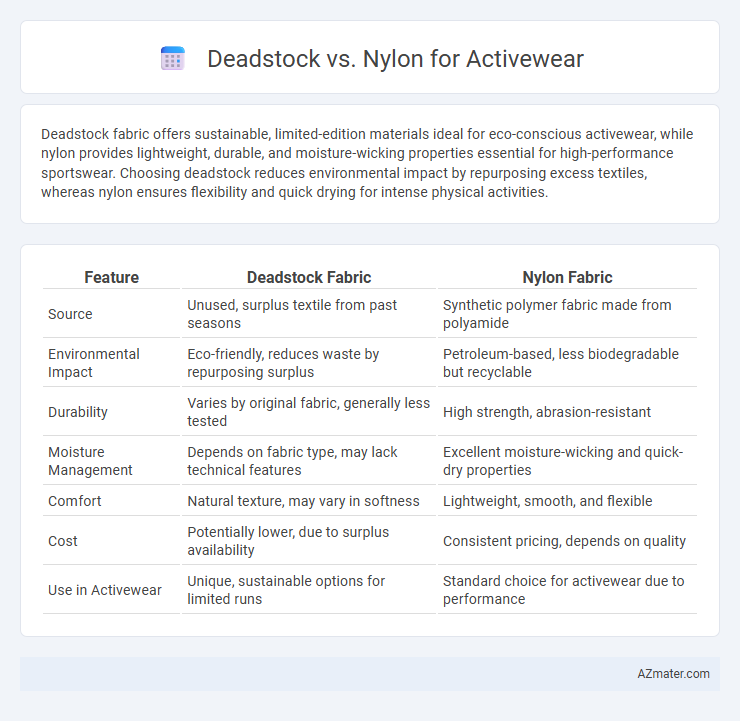Deadstock fabric offers sustainable, limited-edition materials ideal for eco-conscious activewear, while nylon provides lightweight, durable, and moisture-wicking properties essential for high-performance sportswear. Choosing deadstock reduces environmental impact by repurposing excess textiles, whereas nylon ensures flexibility and quick drying for intense physical activities.
Table of Comparison
| Feature | Deadstock Fabric | Nylon Fabric |
|---|---|---|
| Source | Unused, surplus textile from past seasons | Synthetic polymer fabric made from polyamide |
| Environmental Impact | Eco-friendly, reduces waste by repurposing surplus | Petroleum-based, less biodegradable but recyclable |
| Durability | Varies by original fabric, generally less tested | High strength, abrasion-resistant |
| Moisture Management | Depends on fabric type, may lack technical features | Excellent moisture-wicking and quick-dry properties |
| Comfort | Natural texture, may vary in softness | Lightweight, smooth, and flexible |
| Cost | Potentially lower, due to surplus availability | Consistent pricing, depends on quality |
| Use in Activewear | Unique, sustainable options for limited runs | Standard choice for activewear due to performance |
Understanding Deadstock Fabric
Deadstock fabric refers to unused, leftover textile stock from previous manufacturing runs that has never been sold or used in production, offering a sustainable option for activewear brands seeking to reduce waste. Unlike nylon, which is a synthetic fiber known for its durability, elasticity, and moisture-wicking properties, deadstock fabric varies widely in composition and performance depending on its original purpose. Utilizing deadstock materials in activewear combines eco-conscious practices with unique fabric textures and patterns, potentially enhancing product appeal while minimizing environmental impact.
What is Nylon in Activewear?
Nylon in activewear is a synthetic fiber known for its exceptional strength, elasticity, and moisture-wicking properties, making it ideal for high-performance sportswear. Its durability and resistance to abrasion ensure longevity, while its lightweight nature enhances comfort during intense workouts. Nylon's ability to dry quickly and maintain breathability supports temperature regulation and optimal athletic performance.
Sustainability: Deadstock vs Nylon
Deadstock fabric reuses surplus textile materials, significantly reducing waste and lowering carbon footprints compared to the production of virgin nylon, which relies on fossil fuels and energy-intensive processes. Nylon's synthetic nature leads to microplastic pollution during washing, while deadstock fabric repurposes existing materials, minimizing environmental impact. Choosing deadstock promotes circular fashion by extending textile life cycles, whereas nylon, despite durability, contributes to environmental degradation through resource extraction and pollution.
Performance and Durability Comparison
Deadstock fabrics often lack the engineered stretch and moisture-wicking properties found in Nylon, limiting performance in high-intensity activewear. Nylon excels with superior abrasion resistance, elasticity, and quick-drying capabilities, making it ideal for durability in rigorous activities. While deadstock materials offer sustainability benefits by repurposing fabric, Nylon's advanced fiber technology ensures longer-lasting performance under repeated wear and wash cycles.
Comfort and Fit: Which Wins?
Deadstock fabric, often made from pre-existing, high-quality materials, offers a unique softness and durability that enhances comfort in activewear, while nylon provides excellent stretch and moisture-wicking properties for a snug, flexible fit. Nylon's lightweight and breathable nature contribute to superior fit retention during intense physical activity, making it ideal for dynamic movements. Comfort-wise, deadstock's vintage appeal adds a distinct tactile experience, but nylon's engineered fibers typically deliver more consistent performance in terms of elasticity and moisture management.
Style and Aesthetics Differences
Deadstock fabrics offer unique, vintage-inspired patterns and textures that create a distinct, retro aesthetic for activewear, appealing to those seeking individuality and sustainable fashion. Nylon, known for its smooth, sleek finish, provides a modern, high-performance look with a shiny or matte surface that enhances a streamlined, athletic style. The contrasting visual appeal of deadstock's artisanal character versus nylon's polished appearance defines the style and aesthetic choices in activewear design.
Moisture-Wicking and Breathability
Deadstock activewear fabrics, often made from recycled or leftover materials, offer unique sustainability benefits but may vary widely in moisture-wicking and breathability depending on the original textile content. Nylon, a synthetic fiber commonly used in activewear, excels in moisture-wicking by rapidly drawing sweat away from the skin and provides excellent breathability due to its lightweight and engineered knit structures. For optimal performance in activewear, nylon generally outperforms deadstock fabrics in managing moisture and enhancing airflow, ensuring better comfort during intense physical activities.
Cost Considerations for Consumers
Deadstock fabric often presents a cost-effective option for activewear due to its availability as leftover or surplus material from previous production runs, resulting in significantly lower prices compared to newly manufactured Nylon. Nylon, while offering superior durability, moisture-wicking, and elasticity benefits crucial for high-performance activewear, usually commands higher retail costs driven by its specialized production processes and synthetic fiber technology. Consumers seeking budget-friendly activewear may prefer deadstock materials, but those prioritizing longevity and technical performance might justify the premium price of Nylon garments.
Ethical Impact of Fabric Choices
Deadstock fabric significantly reduces environmental waste by repurposing surplus textiles that would otherwise end up in landfills, making it a sustainable choice for activewear production. Nylon, while durable and moisture-wicking, is a synthetic fiber derived from petrochemicals, contributing to greenhouse gas emissions and microplastic pollution during wear and washing. Opting for deadstock materials helps lower the carbon footprint and supports circular fashion, whereas nylon poses ongoing ethical challenges related to resource extraction and environmental degradation.
Best Uses for Deadstock and Nylon in Activewear
Deadstock fabric excels in sustainable activewear by repurposing surplus materials, offering unique patterns and minimizing environmental impact, ideal for limited-edition or eco-conscious collections. Nylon, known for its durability, moisture-wicking, and quick-drying properties, is best suited for high-performance activewear requiring stretch, breathability, and long-lasting wear, such as leggings and sports bras. Combining deadstock with nylon blends can create fashionable yet functional activewear that balances sustainability with technical performance.

Infographic: Deadstock vs Nylon for Activewear
 azmater.com
azmater.com